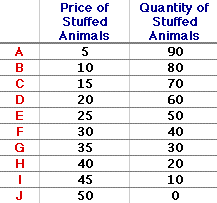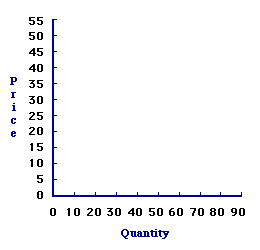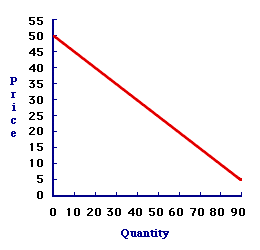
|
|
FEDERAL ADVISORY COUNCIL: A group consisting of Presidents from 12 commercial banks, one from each of the 12 Federal Reserve Districts. This council has no policy making role, but merely offers advice, suggestions, and feedback on how Federal Reserve policies are affecting commercial banks and their customers in non-bank public.
Visit the GLOSS*arama
|
|


|

|
                           DEMAND CURVE: A graphical representation of the relation between the demand price and quantity demanded, holding all ceteris paribus demand determinants constant. A demand curve graphically illustrates the law of demand, the inverse relation between demand price and quantity demanded for a particular good. It is one half of the standard market model; a supply curve is the other half. A demand curve is a useful graph that can summarize several of the more important aspects of demand. It graphically illustrates the law of demand and when combined with the supply curve forms the market model, one of the most useful tools found in economic analysis.Plotting the NumbersA demand curve is commonly derived from a simple demand schedule, such as the one for stuffed Yellow Tarantulas, a cute and cuddly stuffed creature from the Wacky Willy Stuffed Amigos line of collectibles, shown in the left half of the exhibit below. This schedule illustrates the law of demand relation between demand price and quantity demanded. As the demand price increases from $5 to $50, the quantity demanded decreases from 90 to 0 Yellow Tarantulas.
| Demand Schedule | Demand Curve |  |  | |
Transferring the price-quantity pairs from the demand schedule to a graph reveals the demand curve for stuffed Yellow Tarantulas. This task is easily accomplished by clicking the [Plot] button. A $5 price is associated with 90 stuffed animals; a $10 price goes with 80 stuffed animals; and on it proceeds, until finally a $50 price is paired with 0 stuffed animals.The demand curve is finalized by connecting these 10 points with a continuous line. The 10 prices corresponding to these 10 points, are but 10 of an infinite number of prices, each with a corresponding quantity. A continuous line includes these other possibilities. To reveal this line, click the [Draw] button. The end result is the demand curve. What It All MeansA Demand Curve
Yellow Tarantulas |  |
Here are a few observations about this demand curve. - First, as the price increases from a low of $5 to a high of $50, the quantity demanded of Yellow Tarantulas decreases from 90 to 0. Higher prices are related to smaller quantities. This relation, this inverse relation between demand price and quantity demanded, IS the basic law of demand.
- Second, the demand curve represents maximum values. That is, if the price is $40, then the maximum quantity demanded is 20 Yellow Tarantulas. It is not 50, nor even 21, but only 20. Alternatively, if buyers buy 20 Yellow Tarantulas, then the maximum demand price they are willing and able to pay is $40, not $50, not even $40.01, but $40.
- Third, this whole curve, every price-quantity combination on the curve, is demand. Demand is the entire range of prices and quantities, all pairs. Demand is the entire curve. In contrast, quantity demanded is any specific number of Yellow Tarantulas buyers are willing and able to buy at a specific demand price. Selecting a different price generates a different quantity demanded. Quantity demanded is a point on the curve.
- Fourth, this demand curve represents hypothetical possibilities. It suggests a "What if" relation between demand price and quantity demanded. It indicates quantity demanded given a demand price, or demand price given the quantity demanded. If, for example, the demand price is $10, then buyers are willing and able to buy 100 Yellow Tarantulas. This does not mean that buyers will buy, are buying, or ever will buy 100 Yellow Tarantulas. It only indicates what they would buy at a $10 price.

Recommended Citation:DEMAND CURVE, AmosWEB Encyclonomic WEB*pedia, http://www.AmosWEB.com, AmosWEB LLC, 2000-2025. [Accessed: July 18, 2025].
Check Out These Related Terms... | | | | | | | | | |
Or For A Little Background... | | | | | | | | | | | | |
And For Further Study... | | | | | | | | | | | | |
Search Again?
Back to the WEB*pedia
|



|

|
PURPLE SMARPHIN
[What's This?]
Today, you are likely to spend a great deal of time flipping through mail order catalogs trying to buy either a flower arrangement for your aunt or a birthday greeting card for your uncle. Be on the lookout for rusty deck screws.
Your Complete Scope
This isn't me! What am I?
|

|
|
The penny is the only coin minted by the U.S. government in which the "face" on the head looks to the right. All others face left.
|

|
|
"A winner is someone who recognizes his God-given talents, works his tail off to develop them into skills, and uses those skills to accomplish his goals. " -- Larry Bird, basketball player
|

|
ACH
Automated Clearinghouse
|

|
|
Tell us what you think about AmosWEB. Like what you see? Have suggestions for improvements? Let us know. Click the User Feedback link.
User Feedback
|


|


